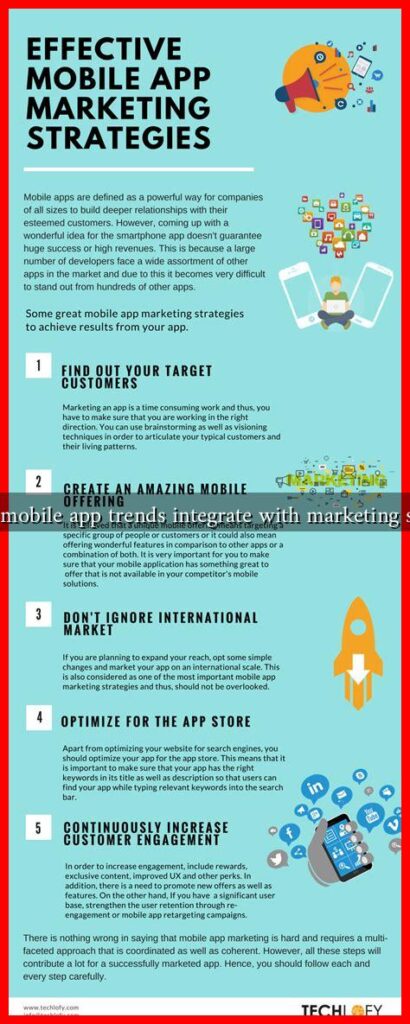-
Table of Contents
- How Do Mobile App Trends Integrate with Marketing Strategies?
- The Rise of Mobile-First Strategies
- Leveraging User Experience (UX) and Personalization
- Incorporating Augmented Reality (AR) and Virtual Reality (VR)
- Utilizing Push Notifications and In-App Messaging
- Case Studies: Successful Integration of Mobile Trends and Marketing
- Conclusion
How Do Mobile App Trends Integrate with Marketing Strategies?
In today’s digital landscape, mobile applications have become a cornerstone of marketing strategies for businesses across various sectors. With the increasing reliance on smartphones and mobile devices, understanding how mobile app trends integrate with marketing strategies is crucial for brands aiming to enhance customer engagement and drive sales. This article explores the latest mobile app trends and their implications for marketing strategies, providing insights and examples to illustrate their effectiveness.
The Rise of Mobile-First Strategies
As mobile usage continues to outpace desktop, businesses are adopting mobile-first strategies. According to Statista, mobile devices accounted for over 54% of global website traffic in 2021, a trend that is expected to grow. This shift has prompted marketers to prioritize mobile app development and optimization in their strategies.
- Responsive Design: Ensuring that websites and apps are mobile-friendly is essential. Brands like Starbucks have successfully implemented responsive designs, allowing users to navigate their services seamlessly across devices.
- Mobile-Optimized Content: Content must be tailored for mobile consumption. Shorter videos, bite-sized articles, and interactive content are more engaging for mobile users.
Leveraging User Experience (UX) and Personalization
Mobile app trends emphasize the importance of user experience and personalization. A well-designed app can significantly enhance customer satisfaction and loyalty. According to a study by PWC, 73% of consumers say that a good experience is key in influencing their brand loyalties.
- Intuitive Navigation: Apps like Airbnb focus on intuitive navigation, making it easy for users to find what they need quickly.
- Personalized Recommendations: Utilizing data analytics, brands can offer personalized content and product recommendations. For instance, Netflix uses algorithms to suggest shows based on user preferences, enhancing user engagement.
Incorporating Augmented Reality (AR) and Virtual Reality (VR)
Augmented Reality (AR) and Virtual Reality (VR) are transforming how brands interact with consumers. These technologies create immersive experiences that can significantly enhance marketing efforts.
- Interactive Advertising: Brands like IKEA have integrated AR into their apps, allowing users to visualize furniture in their homes before making a purchase.
- Virtual Try-Ons: Cosmetic brands like Sephora use AR to enable customers to try on makeup virtually, increasing the likelihood of purchase.
Utilizing Push Notifications and In-App Messaging
Push notifications and in-app messaging are powerful tools for engaging users and driving conversions. According to Localytics, users who opt-in to push notifications engage with apps 88% more than those who do not.
- Timely Offers: Brands can send personalized offers and discounts through push notifications, encouraging immediate action. For example, Domino’s uses push notifications to remind customers of their favorite orders.
- User Engagement: In-app messaging can be used to guide users through new features or provide customer support, enhancing the overall user experience.
Case Studies: Successful Integration of Mobile Trends and Marketing
Several brands have successfully integrated mobile app trends into their marketing strategies, yielding impressive results.
- Starbucks: The Starbucks app not only allows for mobile ordering but also integrates a rewards program that encourages customer loyalty. The app has over 24 million active users, showcasing the effectiveness of combining mobile trends with marketing strategies.
- Nike: Nike’s app offers personalized training plans and integrates social sharing features, allowing users to connect with friends. This approach has led to increased user engagement and brand loyalty.
Conclusion
As mobile app trends continue to evolve, integrating these trends into marketing strategies is essential for businesses looking to thrive in a competitive landscape. By focusing on mobile-first strategies, enhancing user experience, leveraging AR/VR, and utilizing push notifications, brands can create meaningful connections with their customers. The successful case studies of companies like Starbucks and Nike illustrate the potential of these integrations. As we move forward, staying attuned to mobile app trends will be vital for marketers aiming to engage their audience effectively and drive business growth.
For more insights on mobile marketing strategies, you can visit Forbes.


